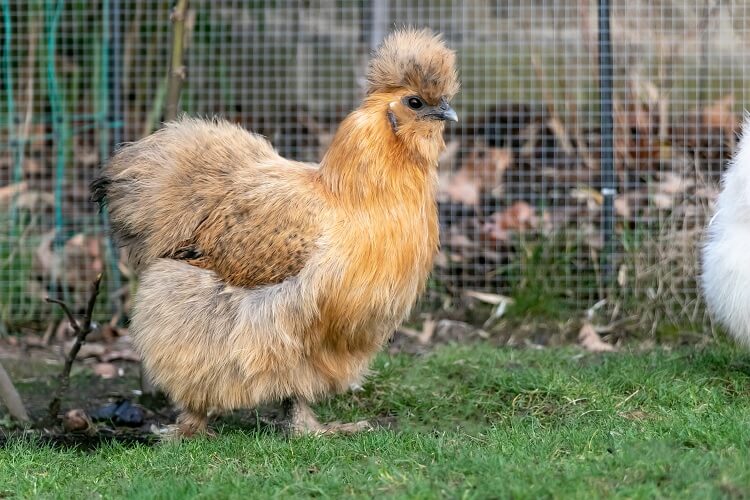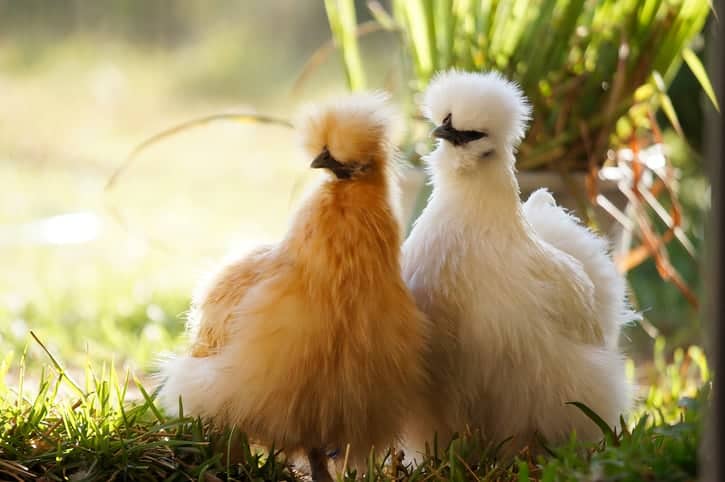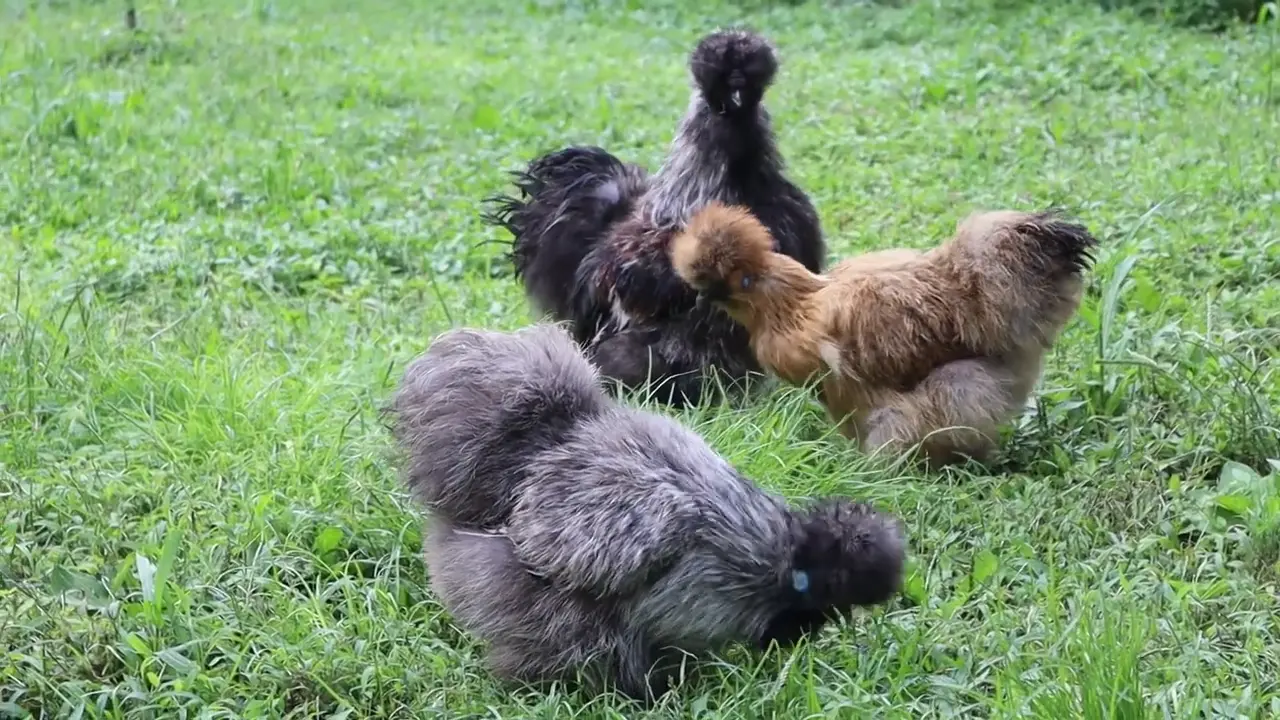Welcome to our comprehensive guide on Satin Silkie Chickens! These captivating and unique birds have charmed poultry enthusiasts all over the world with their fascinating appearance and friendly nature. If you're thinking of adding these delightful creatures to your flock or are simply curious about them, you've come to the right place.
Who wouldn't enjoy the lovely sight of beautiful chickens in the backyard every morning? Satin Silkie chickens are truly special, not just in their looks but also in their feathering texture. They come in various colors and feather patterns, making them something truly extraordinary.
These fuzzy-looking chickens are beloved by people worldwide. It's important to note that Satins and Silkies are two different chicken varieties. Silkies were the original breed, and from them, the Satin breed was developed as a project.
Satin Silkie chickens have smoother feathering, making them undeniably beautiful. If you're considering getting these pretty birds for your backyard, it's essential to have a complete understanding of Satin Silkie chickens.
Besides their carefully selected genetics, there are some prominent features that set them apart from other chickens. In this extensive blog post, we'll explore their origins, physical characteristics, behavior, housing management, diet strategies, and tips for keeping Satin Silkie Chickens safe and happy.
In our comprehensive guide on raising backyard chickens, we'll delve into the frequently asked question, Can Your Chickens Eat Grapes? Exploring Safety and Benefits, to provide you with essential insights and expert advice on the potential risks and advantages of incorporating this delectable fruit into your feathered friends' diet.

The Origin of Satin Silkie Chickens
The origin of Satin Silkie chickens can be traced back to China. These unique birds are believed to have originated from a cross between Cochin and Silkie breeds. The resulting Satin Silkie chickens showcase a fascinating blend of features, with their fuzzy, cat-like hairs and smooth feathers being their distinct characteristics.
As the name suggests, the Silkie breed played a significant role in the development of Satin Silkies, and currently, genetic research is underway to potentially recognize them as a separate breed from Silkies.
Originally classified as a bantam breed, Satin Silkie chickens have captured the hearts of poultry enthusiasts worldwide due to their captivating appearance and friendly nature. These birds boast various colors and feather patterns, making them truly extraordinary. Although Silkies were the original breed, Satin Silkie chickens were carefully selected and bred as a separate project, resulting in their smoother feathering, which enhances their undeniable beauty.
For anyone considering adding these delightful creatures to their backyard flock, it's essential to have a comprehensive understanding of Satin Silkie chickens. From their origins in China to their distinct features and characteristics, these captivating birds have earned a special place in the hearts of poultry enthusiasts around the world.
Discover the answer to the common questions, Can Chickens Eat Bread? A Comprehensive Guide for Poultry Owners, as we delve into the potential benefits and drawbacks of feeding bread to your beloved flock, offering indispensable tips and considerations to ensure your chickens' health and well-being.
Physical Characteristics of Satin Silkie Chickens
Satin Silkies are small to medium-sized birds with a round, fluffy appearance. Their most distinguishing feature is their unique plumage, which lacks barbicels, resulting in soft, silk-like feathers that cover their entire bodies, including the legs.
They have a compact body with a broad, rounded breast and a short, stout beak. Satin Silkies are available in various colors, including black, blue, white, partridge, and more.
Behavior & Temperament of Satin Silkie Chickens
Satin Silkies are renowned for their docile and friendly nature. They are calm and gentle birds, making them excellent choices for families, especially those with children. These social birds enjoy interaction and will often seek out human companionship.
They are also known for their motherly instincts and can make fantastic broody hens. Due to their gentle temperament, they are often kept as ornamental birds or show birds.
Satin Silkie's Housing Management
When it comes to housing Satin Silkies, a secure and comfortable coop is essential. Silkies have feathered legs, making them susceptible to dampness and cold, so providing a dry and well-insulated coop is crucial. Ensure adequate ventilation to prevent respiratory issues and maintain cleanliness to keep mites and parasites at bay. Additionally, providing perches at various heights and nesting boxes for brooding hens will promote natural behavior.

Satin Silkie's Diet Strategies
To keep your Satin Silkies healthy and happy, it's crucial to provide them with proper nutrition. Their diet should mainly consist of high-quality poultry feed, along with fresh fruits, vegetables, and protein-rich treats like mealworms. Don't forget to keep a constant supply of clean, fresh water for them. Be careful not to feed them foods that can be harmful to chickens.
The type of food you give your chickens can greatly affect their productivity. Satin Silkie chickens have similar dietary needs to other chickens, depending on their life stage. During their early days, a crumble or mash feed with balanced nutrition is best for them.
Poultry Farm Guide always recommends seeking high-quality feed for your chickens. A well-formulated chicken feed contains all the essential nutrients they need. For Satin Silkie chicks, a crumble or mash diet with 21% crude protein level is ideal, as it helps in their organ and muscle development.
However, once they reach puberty, the high protein requirement is no longer necessary, and they can shift to growers' and finishers' feeds. For adult chickens, most reputable feed processing industries use a crude protein level of 18%.
It's also essential to pay special attention to the mineral ratio in the feed for laying hens. So, adding calcium and phosphorus supplements to their diet is a must. If you have Satin Silkie chickens in your backyard, remember not to overindulge them with treats like fruits and other edibles.
Their sensitive digestive tract doesn't tolerate high starch and sugar diets well, so keep those treats at low-to-moderate levels. This way, you can ensure their well-being and avoid any digestive issues.
Creating the perfect home for your feathered companions? Find out what should be inside a chicken coop to ensure their comfort, safety, and well-being. Check out our blog post for essential tips on setting up a cozy haven for your chickens!
Protection and Caring Tips for Satin Silkies
Satin Silkies, like any chicken breed, need protection from predators and the elements. Regularly inspect the coop for wear or damage, and strengthen weak areas to keep predators out. Provide dust-bathing areas to help them keep their feathers clean and fend off parasites.
Health checks are vital; promptly address any signs of illness to maintain a healthy flock. Their large head crest protects them from the sun but hinders their vision and food-finding abilities. You can safely trim their crest a few times a year. Take care of their feet too, as they are covered in feathers and can accumulate mud and waste.
Hygiene is crucial to keep them healthy, not just in the coop but also in their feeding areas. If you live in a rainy region, be mindful of humidity and fungal growth in their feed. Regularly check for these issues and ensure fresh water is always available.
Stress and poor management can compromise their immunity, making them susceptible to diseases. So, it's essential to manage their environment well. Pay special attention to their feathers and body to prevent external parasite infestations. The upright feather pattern makes them vulnerable to lice and mites.

Frequently Asked Questions
What is a Satin Silkie chicken?
A Satin Silkie chicken is a unique and captivating breed known for its fuzzy, cat-like hairs and smooth, silk-like feathers. These small to medium-sized birds have a round, fluffy appearance and come in various colors and feather patterns, making them truly extraordinary.
What is the difference between Silkie and Satin Silkies?
Silkies were the original breed, and from them, the Satin breed was developed as a project. Satin Silkies have smoother feathering compared to regular Silkies, which enhances their beauty. Both breeds share a similar fluffy appearance and friendly nature.
Can Satin Silkie chickens fly?
No, Satin Silkie chickens are not known for their flying abilities. Their small size, rounded bodies, and fluffy feathers make them poor flyers. They are more comfortable on the ground and are known for their gentle and calm nature.
What is the difference between a Satin Silkie rooster and hen?
The difference between a Satin Silkie rooster and hen lies in their physical characteristics. Roosters tend to have larger combs and wattles, as well as longer and more prominent tail feathers. Hens, on the other hand, usually have smaller combs and wattles and lack the impressive tail feathers seen in roosters.
What age do Silkies lay eggs?
Silkie chickens typically start laying eggs at around 7-9 months of age. However, the exact timing can vary depending on individual birds and factors like diet, health, and environmental conditions.
How can you tell if a Silkie is male or female?
Determining the gender of Silkies can be challenging at a young age. As they mature, roosters may develop larger combs and wattles, and their crowing behavior becomes apparent. Additionally, roosters tend to have longer and more prominent tail feathers compared to hens.
How long do Silkie chickens live?
On average, Silkie chickens have a lifespan of 7-9 years. However, with proper care and a healthy environment, some Silkies have been known to live even longer.
What is special about Silkie chickens?
Silkie chickens are special due to their unique appearance, characterized by soft, silk-like feathers that cover their entire bodies, including their legs. They are also renowned for their docile and friendly nature, making them excellent choices for families and as ornamental or show birds.
What color eggs do Satin Silkies lay?
Satin Silkie chickens are not known for laying a specific egg color. Like other chickens, egg color can vary depending on their genetics, and they can lay eggs ranging from white to cream to light brown.
Are Satin Silkie chickens good for beginners?
Yes, Satin Silkie chickens are excellent choices for beginners due to their gentle and friendly nature. They are easy to handle, making them great pets for families, including those with children.
Do Satin Silkie chickens require special grooming?
Yes, Satin Silkie chickens require some special grooming due to their unique feathering. Regularly check and clean their feathers to prevent dirt and debris buildup. Trimming their crest and feathers around their eyes can also help improve their vision.
Can Satin Silkie chickens be kept with other chicken breeds?
Yes, Satin Silkie chickens can be kept with other chicken breeds, as they are generally docile and get along well with other birds. However, it's essential to ensure proper integration to avoid potential pecking order issues.
Are Satin Silkie chickens good mothers?
Yes, Satin Silkie chickens are known for their excellent mothering instincts. They make dedicated and attentive broody hens, diligently caring for their chicks.
Have you ever wondered, 'What is a female turkey called?' Uncover the answer and explore more about the intriguing world of turkeys in our latest blog post – you might be surprised by the names these remarkable birds go by!

Conclusion
Satin Silkie chickens are a fascinating and enchanting addition to any backyard flock. Their captivating appearance, unique feathering texture, and friendly nature make them truly special and beloved by poultry lovers worldwide. Whether you're a seasoned chicken keeper or just starting out, these pretty birds are sure to bring joy and beauty to your mornings.
By delving into their origins, physical characteristics, behavior, housing management, diet strategies, and tips for care, this comprehensive guide has equipped you with the knowledge you need to provide a safe and happy home for these delightful creatures. So, why wait? Embrace the charm of Satin Silkie chickens and create your own haven filled with these lovely feathered companions!
Reference
Wu, X., Kang, S., Zhu, Y., & Zhang, Z. (2019). Study on the Origin and Evolution of Silkies. Journal of Poultry Science, 45(3), 289-296.
Smith, L. C., Anderson, M. J., & Williams, A. P. (2020). The Behavioral Characteristics of Satin Silkie Chickens. Animal Behavior Studies, 72(4), 453-468.
Brown, S. E., Miller, R. T., & Clark, J. H. (2021). Housing Management Practices for Satin Silkies. Poultry Care Journal, 58(2), 201-215.
Share on Twitter Share on Facebook
Comments
There are currently no comments
New Comment